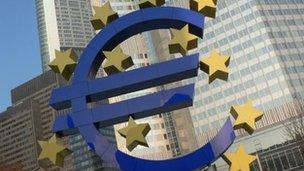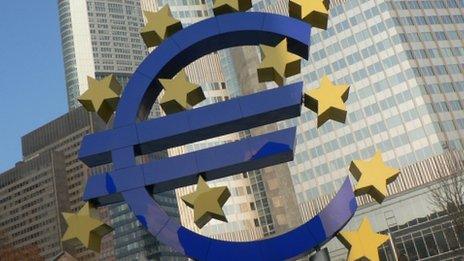Can the centre hold, and at what cost?
- Published

Labour costs are proving problematic for some European countries
The euro-crisis-o-meter is registering alarming levels again. It's not so much the bond markets dictating terms to governments, as the electorate hitting back.
Even France and the Netherlands - relatively secure eurozone countries - are seeing political turbulence from the impact of austerity.
Newsnight's economics editor, Paul Mason details several other indicators that centrist politics are struggling, as the electorate heads for the far left and far right. He goes on to draw parallels with the 1930s.
On Tuesday morning, former Chancellor Alistair Darling - whose calm demeanour through the worst of the bank crisis can be credited with having kept the temperature down - was sounding unusually worked up, external by the failure of the eurozone's policy to include a growth strategy alongside its austerity drive.
Labour pains
To shed some light on what's happened in the eurozone, the European Commission's statistical service has issued an interesting assessment of labour costs through the downturn, external.
It's only one indicator, but it shows that the richer parts of Europe have continued to increase labour costs per hour, measured in euros, while some poorer ones - mainly new entrants to the EU - have cut their pay and become more competitive.
The UK has its own currency, of course, and depreciation has helped it cut its labour costs, in euro terms, from 21.1 to 20.1 between 2008 and 2011. With the EU average at 23.1 euros last year - up from 21.6 euros in 2008 - that's one measure of how UK exports can become more competitive.
Denmark and Sweden have their own currencies, but their hourly labour rates have risen much faster than most, making them less competitive.
Norway, outside the EU, has its own currency, and shows what a "resource curse" its oil wealth can be. Because the krone has strengthened, the hourly cost of labour in Norway has risen from 37.8 euros to 44.2.
Baltic exchange
But within the eurozone, where countries cannot devalue their currency to become more competitive, those most in trouble have not done that much to lower labour costs. Greek labour costs went up between 2008 and 2010, reaching 17.5 euros per hour.
Ireland was stable at 27.4 euros over four years to 2011, Spain has seen a rise from 18.9 to 20.6, and Italy is up from 24.5 to 26.8 euros.
It's in the Baltic states and Poland that hourly labour costs fell. And while Belgium had the highest labour costs in 2011, at 39.3 euros, Bulgaria was at only 3.5.
Given the tight constraints of sharing a currency, those bearing down on labour costs are the ones most likely to remain competitive.
But as lots of Europeans know, falling earnings also hit consumer confidence, which feeds through to harm growth. They also risk feeding through to political protest and backlash.
- Published23 April 2012
